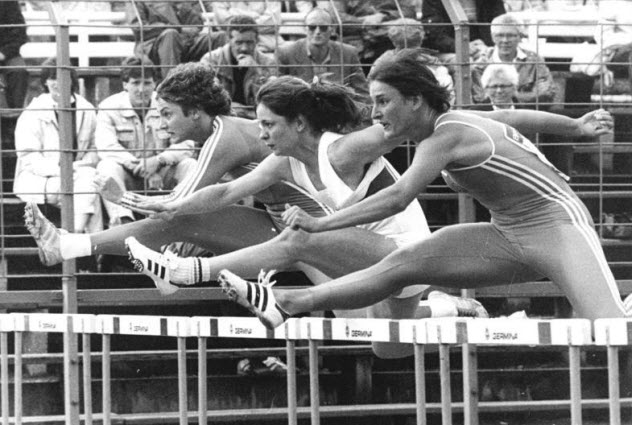 Our World
Our World  Our World
Our World  Pop Culture
Pop Culture 10 Incredible Female Comic Book Artists
 Crime
Crime 10 Terrifying Serial Killers from Centuries Ago
 Technology
Technology 10 Hilariously Over-Engineered Solutions to Simple Problems
 Miscellaneous
Miscellaneous 10 Ironic News Stories Straight out of an Alanis Morissette Song
 Politics
Politics 10 Lesser-Known Far-Right Groups of the 21st Century
 History
History Ten Revealing Facts about Daily Domestic Life in the Old West
 Weird Stuff
Weird Stuff 10 Everyday Products Surprisingly Made by Inmates
 Movies and TV
Movies and TV 10 Actors Dragged out of Retirement for One Key Role
 Creepy
Creepy 10 Lesser-Known Shapeshifter Legends from Around the World
 Our World
Our World 10 Science Facts That Will Change How You Look at the World
 Pop Culture
Pop Culture 10 Incredible Female Comic Book Artists
 Crime
Crime 10 Terrifying Serial Killers from Centuries Ago
Who's Behind Listverse?

Jamie Frater
Head Editor
Jamie founded Listverse due to an insatiable desire to share fascinating, obscure, and bizarre facts. He has been a guest speaker on numerous national radio and television stations and is a five time published author.
More About Us Technology
Technology 10 Hilariously Over-Engineered Solutions to Simple Problems
 Miscellaneous
Miscellaneous 10 Ironic News Stories Straight out of an Alanis Morissette Song
 Politics
Politics 10 Lesser-Known Far-Right Groups of the 21st Century
 History
History Ten Revealing Facts about Daily Domestic Life in the Old West
 Weird Stuff
Weird Stuff 10 Everyday Products Surprisingly Made by Inmates
 Movies and TV
Movies and TV 10 Actors Dragged out of Retirement for One Key Role
 Creepy
Creepy 10 Lesser-Known Shapeshifter Legends from Around the World
10 Famous Intersex Athletes
Intersex people in sports have generated huge controversy. In particular, those who compete as women are often seen as having an unfair advantage in strength, stamina, speed, or size. Frequently, these individuals have been publicly humiliated—described as “freaks” and “cheats” and subjected to physical examinations that violate their personal privacy and dignity.
Their hard work has sometimes been for nothing as they have been disqualified from competing or retrospectively stripped of titles and medals. Their sexual anatomy has sadly overshadowed some truly great human achievements and raised some uncomfortable questions about our gender binary prejudices.
10 Pinki Pramanik
Pinki Pramanik was an Indian female track runner, specializing in 400- and 800-meter events. Her career was advancing well until she encountered some disturbing harassment. Some youths planted a gun on her and brought it to the attention of police. She was prevented from competing at an event but was eventually cleared of all charges as eyewitnesses confirmed her innocence. Even so, she took three months off to recover from the incident.
While her results and track times suffered after this initial persecution, she went on to win a silver medal for her country as part of the 400-meter women’s relay team at the 2006 Commonwealth Games. She also won several gold medals at smaller events before retiring from athletics. However, the gun-planting incident was only the beginning of the attempts to frame her for crimes she didn’t commit. In 2012, she was publicly accused of being male and of having raped a woman.
Initial gender testing in the wake of these allegations was inconclusive. However, Pramanik was held in a male prison without bail for 26 days while these tests were conducted. A clip which showed her naked was also leaked online and went viral at the time. She claimed that the tests occurred without her consent while she was drugged and had her hands and feet tied.
A more advanced chromosome-pattern test was also ordered. Eventually, it was determined that Pramanik was a male pseudohermaphrodite. She had a disorder of sexual development, with an underdeveloped penis and internal testes. Experts argued that this would make her incapable of rape, but the police maintained that she could achieve an erection and still be guilty. How the police knew this is unclear. Pramanik was also suspended from her job because of the allegations.
During the sensational trial, the media referred to the woman who had brought the allegations against Pramanik as her “live-in lover.” But according to Pramanik, the woman was a single mother who had originally lived next door. When the woman’s partner left her, Pramanik took pity on the woman and invited her to move in because she lived alone. The woman lived with Pramanik for several years. At some point, however, this woman took naked photographs of Pramanik and attempted to blackmail her with them.
Throughout the trial, Pramanik insisted that she was female and blamed the compulsory use of testosterone in her training as the cause of her more masculine appearance. After she was found innocent of the rape charge, she stated in an interview with Outlook: “I have locked myself in my house. I don’t want to go out or show my face.”
Eventually, the woman who had made the allegations confessed to having been put up to it by the husband of another famous Indian athlete. This man was in a dispute with Pramanik over some land.
9 Caster Semenya
In 2009, 18-year-old Caster Semenya of South Africa became the center of global media attention after her debut at the world athletics championships in Berlin. However, this had more to do with her elevated testosterone levels than her gold medal in the women’s 800-meter track event (with an impressive time of 1 minute 55.45 seconds).
Semenya allegedly had five times the amount of testosterone that “normal” women have. Outrage was expressed by those who claimed she had an unfair advantage. Subsequent tests revealed that Semenya had internal testes and lacked a womb and ovaries. The results were made public, and Semenya was deeply embarrassed.
“If it wasn’t for my family, I don’t think I could have survived,” she told the BBC in an interview. “I was world champion but I was never able to celebrate it. [ . . . ] It was upsetting, you feel humiliated. [ . . . ] I just want to be me. I was born like this. I don’t want any changes.”
Semenya was classified as a true hermaphrodite. She was advised to have corrective surgery or hormonal treatment before her condition led to potential health problems. The International Association of Athletics Federations (IAAF), which carried out the gender tests, originally considered banning Semenya from competing in future events and revoking her gold medal.
But she was eventually allowed to return. She retained her gold and won silvers at the 2011 World Championships and the 2012 Summer Olympics. But after time away from running, injury, and undergoing the advised treatment for her condition, Semenya never topped her 2009 time of 1 minute 55.45 seconds.
8 Ewa Klobukowska
At the height of the Cold War in 1964, the Summer Games were held in Tokyo. Ewa Klobukowska competed there as part of the Polish team in the 4 X 100-meter relay for women. The Poles beat the somewhat faster American athletes due to their more coordinated exchanges. The Polish team won a gold medal for their country and established a new world record. Klobukowska also picked up a bronze medal in the women’s 100-meter track.
During that time, athletes from the Soviet Union and Eastern Bloc countries like Poland were under general suspicion in the West, and the women were often stereotyped as being unnaturally robust and mannish. They tended to be slandered in the Western media with suggestions of gender cheating or blatant ridicule that called them “freaks of nature.”
In 1968, the IAAF introduced sex chromatin testing for gender identification in an attempt to quash exactly this kind of name-calling and rumormongering. Klobukowska was the first to be singled out. According to the IAAF, she had “one chromosome too many.” She was disqualified from competing in women’s events. Poland was allowed to keep its 1964 gold medal, but the world record time was scratched from the books. The time of the American relay team became the world record instead. In 1968, Klobukowska, who had been classed as a chromosomal male, controversially gave birth to a child.
The IAAF’s decision concerning Klobukowska is now considered to be an injustice because the results of sex chromatin for gender identification are no longer deemed as reliable as they once were.
7 Stella Walsh
Stella Walsh became one the most famous intersex athletes of all time. Throughout her life, though, no one seemed to suspect her of being intersex. She was born in Poland in 1911, christened “Stefania Walasiewicz,” and raised as a girl. Her family emigrated to the US where she soon became known as “Stella Walsh.”
Walsh lived in Cleveland, Ohio, and showed an aptitude for athletics. She became a rising star of track-and-field events and set a new world record in the 100-meter dash in 1930. She was tipped to win gold for America at the 1932 Olympics. But the Great Depression cost Walsh her job with the New York Central Railroad, and she could no longer afford to pay her own way to the Olympics, as many athletes in those days were expected to do.
The Olympic Games of 1932 were held in Los Angeles. The only way Walsh could get there was to take a job with the Polish consulate in New York City. She ended up representing Poland instead of America at the games, which many Americans saw as a betrayal. As a result, her citizenship was delayed by 15 years.
Competing under the name of “Stanislawa Walasiewicz” at the 1932 Olympics, Walsh equaled the world record for the 100-meter race and won gold. The long stride of her running style was likened to that of a man’s. At the next Olympic Games in Berlin in 1936, she once again represented Poland but this time won a silver, losing the gold to her American rival, Helen Stephens, by just 0.2 seconds.
Given Stella’s “betrayal” of her adoptive country, this might have seemed like a poetic end to some people. However, in a weird twist that has largely been forgotten, Helen Stephens actually became the first female athlete to be subjected to an at-event gender examination after accusations that she was a man. She passed, although some might say she was even more mannish than Walsh.
By the end of her career, Walsh had achieved 26 new world records. In 1980, she died when she was gunned down in the cross fire of an armed robbery in Cleveland. The coroner discovered that Walsh had ambiguous genitalia caused by a rare chromosomal disorder known as “chromosomal mosaicism.” Despite the gender confusion this condition may sometimes cause, Walsh lived her entire life as a woman.
6 Maria Patino

Maria Patino represented Spain in the hurdles in the 1980s. Officials had already given her a “certificate of femininity” at the World Track and Field Championships in 1983, but she forgot to take it with her to the World University Games in Japan in 1985.
After submitting to a swab test, Patino—a feminine woman by all outward appearances—was advised to claim an injury and drop out of the competition because her test results were ambiguous and needed clarification. She complied and received a letter two months later with the results. Completely stunned, Patino read that she had failed the test and been officially classified as “male.”
Until that moment, Patino had no idea that she had a Y chromosome, making her intersex. She was diagnosed with androgen insensitivity syndrome (AIS) and disqualified from competing. She challenged the IAAF’s decision and found experts who managed to convince sports federations that her AIS gave her no advantage over other competitors. The IAAF’s decision was reversed but not in time for Patino to compete in the Olympics.
Thanks in no small part to Patino challenging the rules of gender verification testing (GVT), the IAAF dropped compulsory GVT in 1991. The International Olympic Committee followed suit in 1999. However, both organizations still reserve the right to order individual GVT when there are strong doubts about or challenges to a female athlete’s sexual identity (as was the case with Caster Semenya).
5 Santhi Soundarajan

Born into the lowest caste of Indian society, Santhi Soundarajan lived with her parents and four younger siblings in a hut before obtaining a state scholarship. She distinguished herself as a middle-distance runner while studying at a college in Chennai. After breaking national records, Soundarajan went on to win a silver medal at the Asian Athletics Championships in South Korea in 2005. The following year, she represented India at the Asian Games and received another silver medal for her performance in the women’s 800 meters.
The day after her victory at the Asian Games, Soundarajan was called in for tests by the Indian Athletic Federations doctor. The doctor left her with a panel of IAAF-appointed experts, and she underwent a 30-minute physical examination. One day later, she was dismissed from the games. However, she didn’t know why until she saw it on the evening news like everyone else: Soundarajan had been stripped of her medals because she was not, according to the IAAF, a real woman.
Like Maria Patino, Soundarajan had AIS. Unlike Patino, she did not challenge the decision. Depressed, she retreated to her rural village and attempted suicide by ingesting poison. “Everyone looked down on me,” she said in an interview with ESPN. “Everyone was looking at me in this new way: Is she a man? Is she a transvestite? It’s very hurtful. It ruined my life and my family’s life.”
Fortunately, Soundarajan recovered enough to go on. In spite of the stigma, she used some of the prize money that was given to her by the state to set up a school to teach talented but impoverished children how to run. Sadly, this venture did not last as there was not enough money to support it.
Although she had always identified as a woman, Soundarajan eventually found it easier to avoid unwanted attention and rumor by cutting her hair short and dressing and living as a male. Six years after winning her silver medal, she was living in a rudimentary house opposite the hut she grew up in. She makes mud bricks for a living.
4 Erika/Erik Schinegger
Erika Schinegger experienced gender confusion as a child, but she had no clue that she was an “inside-out male” until after she won a gold medal for skiing. Schinegger won the women’s downhill at the Alpine World Ski Championships in Portillo, Chile, in 1966.
Later in her career, at age 20, she underwent testing at the 1968 Winter Olympics at Grenoble, France. It was discovered that her saliva contained only male hormones. She was put through extensive medical and psychological testing, and eventually, her lower torso was opened surgically. A penis and testicles were found to have grown internally. Schinegger underwent several more surgical procedures and officially changed sex, becoming “Erik.”
In 1988, Erik made headlines again when he handed over his 1966 gold medal to former French skier Marielle Goitschel. The exchange was broadcast on Austrian television, and the story was circulated by the European media. By that stage, Eric was 40 years old, married, and a father. He was running a hotel and ski school in the Carinthia region of Austria.
3 Dora, Heinrich, Or Horst Ratjen
Dora Ratjen was central to one of the biggest sports scandals in history. At birth, the midwife announced, “It’s a boy.” But she quickly changed her mind and said, “It’s a girl after all.” When Ratjen got pneumonia some months later, her father asked the doctor to examine his daughter’s genitalia. The doctor told him, “Let it be. You can’t do anything about it anyway.”
“My parents brought me up as a girl,” Ratjen told arresting police officers in Germany in 1938. “I therefore wore girl’s clothes all my childhood. But from the age of 10 or 11, I started to realize I wasn’t female but male. However, I never asked my parents why I had to wear women’s clothes even though I was male.”
Ratjen failed to develop full breasts like other girls and experienced her first male ejaculation at puberty. She ended up having to shave her legs every other day. She became a loner, avoided swimming and social events, and worked with other women in a tobacco factory. When she joined an athletics club in 1934, Ratjen experienced acceptance as a talented “female” high jumper.
Ratjen went on to win gold for Germany at the European Athletics Championships in Vienna in 1938. She cleared the bar in the high jump at 1.70 meters, setting a new world record. On the train home, she was stopped by a policeman as she stretched her legs on the platform at Magdeburg. A ticket inspector had informed the officer that Ratjen was really a man disguised as a woman. The policeman asked Ratjen to accompany him to the station, and Ratjen was arrested that afternoon, charged with suspicion of fraud. Her gold medal was confiscated.
Before this arrest, Ratjen had also previously represented Germany at the 1936 Summer Olympic Games in Berlin. She had placed fourth in the women’s high jump (as shown in the video above). Her teammate, Elfried Kaun, won bronze in the same event. However, Germany had three outstanding female high jumpers at that time. The third, Gretel Bergmann, was deliberately sidelined from the team. Bergmann was Jewish, and Hitler did not want a Jewish girl representing Germany.
Soon after Ratjen’s arrest in Magdeburg in 1938, the charges of fraud were dropped. Ratjen changed her name to “Heinrich” (or “Horst”) and began a new life as a male. In the decades following World War II, this led to a conspiracy theory that the Nazis knowingly replaced a female Jewish athlete with a man. However, it seems much more likely that no one had any idea that Ratjen was a hermaphrodite with ambiguous genitalia and a confused gender identity because she was raised as a girl.
“I never had any suspicions [about Ratjen’s sexual identity], not even once,” said Gretel Bergmann in an interview with Spiegel Online International. “In the communal shower, we wondered why she never showed herself naked. It was grotesque that someone could still be that shy at the age of 17. We just thought, ‘She’s strange. She’s odd.’ ”
2 Zdenka Koubkova/Zdenek Koubek

In 1934, Zdenka Koubkova, a Czechoslovakian track-and-field athlete, became the subject of rumors when she declined to participate in a medical examination that was part of a scientific study on the effects of athletics on women’s bodies.
Soon afterward, she dropped out of athletics and resigned from the Czech Women’s Athletic Federation—which was remarkably suspicious because she had just set a new world record for the women’s 800-meter track at the Women’s World Athletic Championships in London. According to contemporary sources, she was a pseudohermaphrodite.
In 1935, it was revealed that she had undergone a sex change operation and become a man, despite the possibility of being conscripted into military service. She also visited America and performed in a cabaret due to her condition.
1 Edinanci Silva
Edinanci Fernandes da Silva, a Brazilian judoka (female judo wrestler), was born with both male and female sex organs. She underwent surgery in the mid-1990s to officially compete as a woman and was cleared by the IOC to represent Brazil in the 1996 Olympic Games in Atlanta. She didn’t win a medal in 1996, but she did become a world bronze medalist the following year.
Silva competed again in the 2000 Olympics in Sydney but encountered unwanted attention when Australian competitor Natalie Jenkins repeatedly referred to her in a press conference as “he.”
“I have never fought that one before. My plan was not to grip with her, she’s—he’s—very strong,” Jenkins told reporters. Silva gave a mouth swab to officials, which proved she was female. She beat Jenkins but again failed to win an Olympic medal. However, one of her biggest career achievements came that year when she won her category at the Tournoi de Paris in 2000.
HTR Williams is a freelance writer living in New Zealand. To read more of his work or say hello, please visit htrwilliams.com.








